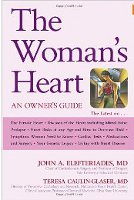
February is American Heart Month – Are Women At Risk For Heart Disease?
Posted on Friday, February 11th, 2011
Heart disease is the leading cause of death for women in the United States.
 Yes, you read that right. Does that surprise you? When it comes to our health, we women often focus on the things that make us female. We march to the tune we’ve heard for decades, taught from age 18 and on to have our yearly pap and breast exam.
Yes, you read that right. Does that surprise you? When it comes to our health, we women often focus on the things that make us female. We march to the tune we’ve heard for decades, taught from age 18 and on to have our yearly pap and breast exam.
Heart disease is thought of as a “man’s disease” by many people, perhaps even your doctor. The fact is, heart disease kills about the same number of women as it does men. Even with this knowledge, a large percentage of women do not believe they themselves are at risk for heart disease.
According to the American Heart Association, nearly twice as many women in the United States die of heart disease, stroke and other cardiovascular diseases as from all forms of cancer, including breast cancer.
Along with this scary news, about two-thirds of women who die suddenly of coronary heart disease had no recognizable symptoms. Which means, even if you don’t fall under a typical pattern of risk factors, you still may have heart disease. Heart disease does not discriminate; it affects women across all lines, including ethnic and cultural.
Not only is heart disease NOT a “man’s disease,” it is also not an “older woman’s disease.” Yes, it’s true that heart disease is the leading cause of death among women aged 65 years and older. But, heart disease is also the second leading cause of death among women aged 45 to 64 years old, and the third leading cause of death among women aged 25 to 44 years old.
So, with all this grim news, what can you do? Let’s look at the risk factors, first. According to the CDC (Centers for Disease Control and Prevention), 9 out of 10 heart disease patients have at least one risk factor. These risk factors, often controllable or avoidable, include:
- High cholesterol
- High blood pressure
- Diabetes
- Cigarette smoking including second hand smoke
- Overweight and obesity
- Poor diet
- Physical inactivity
- Alcohol use
Risk factors that are not controllable or avoidable are your age and heredity. A woman’s risk for heart disease escalates as she grows older. Your family history will also determine if you are at greater risk for heart disease.
The first step is prevention. Of course, you want to live the healthiest lifestyle you possibly can as this is the best defense against heart disease. Making a daily commitment to eat right and stay fit sets up the pattern for a healthy lifetime. Take a look at just a few ways you can start reducing those risk factors:
- Eat lean proteins
- Choose dairy products that are fat free
- Eliminate saturated and trans-fats from your diet
- Avoid partially hydrogenated vegetable oils
- Eat low cholesterol foods
- Reduce foods and beverages containing sugars
- Reduce salt intake
- Keep alcohol consumption to a minimum
- Reduce portion sizes on your plate
- Eat a diet high in dietary fiber
- Eat fewer processed foods
- Eat whole grains
- Add routine physical activity to your daily schedule
None of these items should come as a surprise to you. We all know what to do to get healthy. Now, we just need to do it.
If you still don’t think you’re at risk for heart disease, take a look at the facts. In 2010, an estimated 785,000 Americans had a new coronary attack, and about 470,000 had a recurrent attack. About every 25 seconds, an American will have a coronary event, and about one every minute will die from one, and women make up half this statistic.
Along with prevention comes early detection. Even though some heart attacks come on suddenly, most will start more slowly, perhaps with mild discomfort or pain. This can confuse someone, especially someone who doesn’t think she could possibly be having a heart attack. Knowing the signs of a heart attack is crucial to ensure the most positive outcome. Women need to learn to ask themselves the question “Am I having a heart attack” when experiencing these symptoms, just as a man would:
Chest discomfort – Most heart attacks involve discomfort in the center of the chest that lasts more than a few minutes, or that goes away and comes back. It can feel like uncomfortable pressure, squeezing, fullness, or pain.
Upper body discomfort – This could include pain or discomfort in one or both arms, the back, neck, abdomen, or even the jaw.
Shortness of breath – This symptom may occur with or without chest discomfort.
Other signs – A variety of other signs may occur, including a cold sweat, nausea, vomiting, lightheaded feeling, dizziness, choking feeling, and sudden fatigue.
Heart disease is one place where, unfortunately, women have equality.
It’s time to talk to your doctor. If you are a woman, insist that your doctor give you the same respect in regard to testing for the risks associated with heart disease that he or she would give a man.
Now, spread the word. Click on this short video from one of our favorite ladies, Betty White, then let your friends know that they, not just their husbands and men friends, may be at risk for heart disease. Then, be sure to send your friends the link to this blog, as well as sharing it on Facebook and Twitter. Let’s tell women that they need to take heart disease seriously.
Don’t we just love Betty White! Now, go spread the word.
 p.s. Women may be at the same risk for heart disease as men are, but we have health needs that are specific to our very different bodies and metabolism.
p.s. Women may be at the same risk for heart disease as men are, but we have health needs that are specific to our very different bodies and metabolism.
This book, The Woman’s Heart: An Owner’s Guide by John A. Elefteriades MD and Teresa Caulin-Glaser MD takes a look at the unique factors affecting women’s cardiovascular health.
Take your heart health seriously. Order your Owner’s Guide and begin taking care of your heart the way it deserves to be taken care of.
p.p.s. Valentine’s Day is an excellent time to commit to your heart health. If you want to read a bit more, click here and enjoy my post “Valentine’s Day Is Coming – But This Isn’t About THAT Heart”
For more information on women and heart disease, click on and visit the following websites:
Centers for Disease Control and Prevention
American Heart Association
National Heart, Lung, and Blood Institute






A classmate of mine (I’m 40, graduated in ’88) just had a heart attack. I was thinking, oh she must have gotten overweight like me – or something like that, right? Go to her FB page and she looks to NOT be overweight and she looks healthy! Really woke me up a LOT!!
Thanks, Patti. I tend to be in denial about the dangers of heart disease for women.
Me too, Barbara… or at least I was. What prompted my original post was when my sister-in-law was complaining about feeling like she was having a heart attack. The symptoms kept coming back, and she kept going to her regular doctor asking to have an EKG and was told each time; “No. You don’t need that. Women don’t have heart attacks. It’s probably menopause symptoms or something you ate.”
Luckily, she finally went to a different doctor and was taken seriously. And, yes, she did in fact have high blood pressure and heart disease. She received proper treatment and is now doing very well, living an active lifestyle. Now, she is a non-smoker, non-drinker, and is a tiny little gal. So, she did not present any risk factors, except heredity.
The lesson is, I guess, if your doctor doesn’t take your symptoms seriously (and many don’t!) fire your doctor and find one who does.
Thanks, Barbara, for stopping by to read and comment. I always appreciate you!
Patti, this comprehensive information about heart disease, also a silent disease especially for women, is the best Valentine’s gift you could share, especially the in-depth summary of risk factors. It reminds us to evaluate our life style and make adjustments, however small they may be. For instance, going over the list I realized that I have been less careful with partially hydrogenated oils and trans-fats recently. Though I do not use them for cooking, I LOVE pastry and had been giving in more than I should to get that extra doughnut. Great information, Patti, thanks!
Thank you, Ute. I’m glad you found the article informative and useful. I don’t know if you read one of my other responses to a comment, but in it I mentioned how my sister-in-law was diagnosed with heart disease (treated successfully) but only after she hounded several doctors to “PLEASE give me an EKG!” They kept poo-pooing her symptoms simply because of being female, especially female and menopausal… a combination that makes doctors stupid, I guess. grrrr….
Again, thank you for stopping by and commenting. I sure do love the company here!